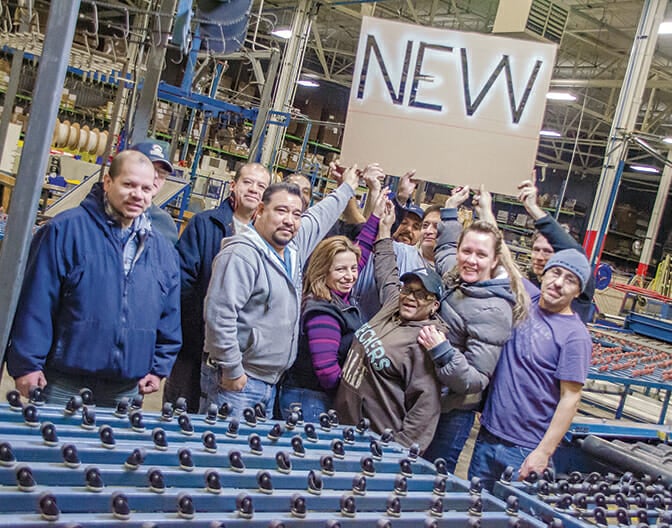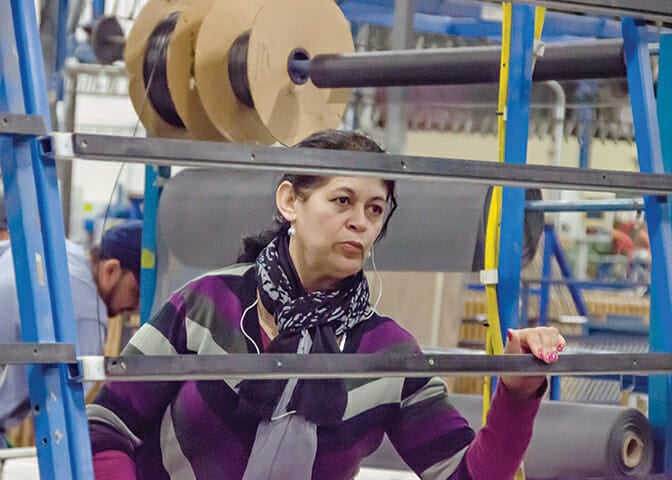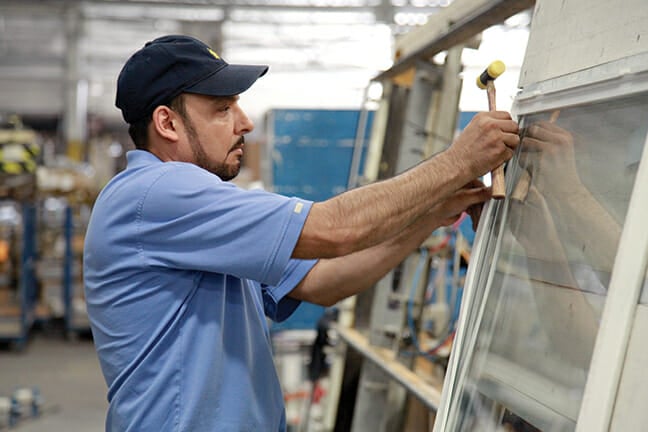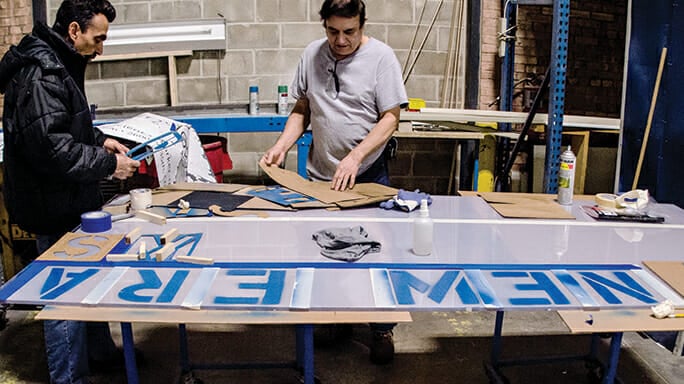
Everyone is equal at New Era Windows Cooperative, a factory on the southwest side of Chicago. There is no owner to answer to because everyone is an owner; there are no outside shareholders to choose a board of directors. There is no boss because the workers fired him.
I paid a visit to the New Era plant, housed in a towering building full of commercial warehouses, to celebrate its grand opening on May 9, 2013. The air was heavy with nervous anticipation and pride. Assigned to decorating duty, I noticed one of the workers, an older fellow who rarely spoke or smiled, redoing my handiwork, rearranging props so they framed the podium symmetrically and rehanging the New Era banner so it was perfectly straight and the knots were evenly spaced. By 3 p.m. about fifty people had arrived—friends and family, union representatives, and local officials—filling a room that had been dark and cavernous only a few months before. The workers had installed lighting and painted the walls, mapped and cut drains in the cement floor, rigged the wiring, and transported massive window-building machines from across town on their own, saving themselves the tens of thousands of dollars it would have cost to hire outside movers. “We used to make windows, and now we can make factories,” said Melvin “Ricky” Maclin, who grew up a sharecropper in Tennessee. When it came time to cut the ribbon, all the workers lent a hand, an attempt to symbolize the difference between New Era and everywhere else they had worked.
There are at least 150 million members of cooperatives in the United States, if you include retail, housing, agricultural, electrical, insurance, and most other types of co-ops. Eleven thousand American companies are owned wholly or in part by their workers through employee stock-ownership plans. Where these two groups intersect and go even further is in the four hundred worker cooperatives that exist in this country, enterprises that are owned by members and democratically run. As for cooperative factories, New Era is a rarity, among the only operations of its kind in the United States.
The story of New Era begins in late 2008, when workers occupied the newly closed Chicago factory of Republic Windows and Doors, demanding the severance and vacation pay they argued they were due under the law. Along with representatives of their union, the United Electrical, Radio and Machine Workers of America (UE), the workers had been staking out the building around the clock, watching and following mysterious trucks hauling away machines and office furniture, confirming their suspicion that the business was not really being shut down at all but rather moved to another state where wages were lower and unions nonexistent. When the closing was officially announced, Republic’s 250 employees, some of whom had clocked thirty years on the job, were given three days notice of their termination. A group of workers decided to risk arrest and refused to go home, blocking anyone from moving or selling the plant’s remaining assets; they didn’t leave for almost a week.
Their timing was good. It was the first sit-down strike in many years, and thanks to the financial crisis and bank bailouts, the public was in no mood for the usual explanations from company management. The unionized Chicago police declined to drag the workers off the property, and soon local, and then national, politicians were falling over themselves to show support. (“I think they’re absolutely right,” said president-elect Barack Obama when a reporter asked for his thoughts on the issue.) Both the Right and the Left rallied to the workers’ defense: the occupation was praised by Fox News and immortalized in Michael Moore’s film Capitalism: A Love Story. Labor activists and corporate executives alike believed the sit-down was a harbinger of things to come, a revival of the moribund labor movement.
Finance, as it is currently set up, is parasitic. But what if it was productive instead? What if it invested in the community instead of always sucking money out?
To appease a public they believed was ready for blood, the company’s bankers quickly granted a settlement, and victory was declared (though workers had to wait until last December to see Republic’s ex-chief, Richard Gillman, finally slapped with a four-year prison sentence for theft). Before long, the publicity attracted the hip CEO of a company called Serious Materials, who believed he could engineer an even happier ending, and make a fortune in the process, by revamping the windows operation. In 2009 Serious Materials bought the factory for $1.45 million, planning to launch a new line of energy-efficient building products that would take advantage of the Obama administration’s green jobs stimulus. Can you say “blue-collar synergy”?
It was a miscalculation. The stimulus never materialized, and production barely got off the ground. Before long, the workers occupied the plant again. This time it took only twelve hours for their demands to be met: they wanted to purchase the company from Serious and run it themselves.
This startling idea had been suggested to Armando Robles, one of the leaders from the fight with Republic, by the documentary film The Take, the story of Argentinean factories where workers practice “horizontalidad,” or democratic self-management. Robles had also met Brendan Martin, a former computer programmer who had been so inspired by The Take that he had moved to Argentina, learned Spanish, and invested his life savings in a rotating loan fund to help factory takeovers and democratic cooperatives flourish and expand, a venture he called the Working World.
When it became obvious that Serious Materials was failing and that the workers were going to lose the jobs they had fought so hard to keep, Robles gave Martin a call. Martin had made small loans and provided assistance to almost two hundred cooperatives in Argentina and Nicaragua, but he had never taken on anything of this size; nor had he ever worked on a project in the United States. He scrambled for money, and in 2012 the workers bought the factory at the fire-sale price of $500,000. The time for bosses had passed.
If you have spent any time on the activist left in the last decade, you will have heard plenty of talk about horizontalism, about consensus decision-making and direct democracy. Occupy Wall Street brought these principles, long commonplace in anarchist circles, to a wider audience. And yet if you joined the movement—as I did, beginning that first, fateful day in Zuccotti Park—it quickly became evident that no one really knew how to put horizontalism into practice. Direct democracy is easier said than done, as the dysfunctional general assemblies of the Occupy movement made clear to most who participated in them. Open political groups, bound by nothing more than shared idealism and overlapping antipathies, often splinter apart when unanimity is elusive.

So far, however, the New Era workers have stayed together. Nearly a year after the launch, the machines are up and running, and window sales are growing slowly but steadily. (The workers believe that minority-owned business certification, soon to be granted, will make them competitive for government contracts that could guarantee solvency.) Nonetheless, the New Era team readily acknowledges that it isn’t always easy to come to agreements and get along. One founding member has quit the group. Another point of contention arose when the workers decided to continue paying a colleague who had to stay home due to his wife’s illness. The debate was fierce, but eventually everyone agreed that they would want to receive the same assistance if they were in his shoes. Day to day, there are personality clashes, differences of opinion, and garden-variety annoyances. But since the workers have kids and grandkids to feed, or relatives back home in Mexico to support, or bills that are piling up, no one can afford to forfeit their share of the rewards they expect to materialize down the road. When I met with them, the workers kept referring to themselves as a “family,” and it was clear the word was meant to convey the combination of affection and irritation, comfort and conflict, that typically attends the bonds of kinship.
Horizontalism is not simply about being fair to old friends. Nor is it about passing a political litmus test or pretending everyone has identical abilities. Instead, it is a practical matter, a way of mitigating the uncertainty and sacrifice the task requires of all involved, even if it means supporting those who are less proficient or those who are unable to work as hard as others due to unforeseen circumstances. Toward this end, the group recently affirmed their commitment to “solidarity economics,” specifically assuring that all future workers will be members. Despite the disproportionate role played by the founders, every worker, present and future, must be given a “buy-in” that will make them all legitimate owners of capital and make it harder for the business to demutualize, as some cooperatives have in the past. Essentially, they want to be blocked from someday becoming the bosses they deplore.
Starting New Era, one worker told me, was a “survival strategy” pure and simple, a way to “stop the abuse” they had suffered. Making windows for Republic, Robles said, was “a type of modern slavery,” with every minute logged and monitored through a complicated tracking system. Now they move freely, working and breaking when they need to, with a sense of purpose that Robles says gets him happily out of bed at dawn without the help of an alarm clock. Arizona Stingley, who was a nanny for white families in Mississippi in her younger days, told me there was simply no comparison between Republic and New Era. “It was divide and conquer by the boss. They were always pitting Mexicans against blacks,” she recalled. “And it worked. People wouldn’t want to teach you anything because they were afraid you’d take their job.” The groups sat at different tables at lunch and rarely mingled across race lines. Now they share skills instead of regarding each other as threats.
Experiences like these have convinced the New Era crew that cooperatives are the wave of the future. “Bosses, at any minute they can close the plant and just destroy your life. They say it’s your job, but really it’s their job to take away,” said Maclin, whose fluency in English is a resource for the predominantly Spanish-speaking crew. He likened his awakening over the last few years to the movie Star Wars: “You know how it says, the power is with you, the force is with you? Well the power is with us. The force is with us. We are the work force. We’re taking back the power we already have.”
Since the earliest outbreak of labor unrest in the United States, workers have held out hope for more than mere survival: they have dreamed of running their own businesses and getting rid of bosses altogether and, by doing so, building a better and more just society. In 1768 twenty journeymen tailors walked off the job in New York City intending to start a cooperative, though there is no record of whether they succeeded. Many laborers, farmers, and consumers would follow their example, building cooperative enterprises and associations. In the 1880s the Knights of Labor represented more than two hundred industrial cooperatives that they hoped would serve as the basis for a “cooperative commonwealth.” History abounds with examples of cooperative ambitions; unfortunately, it also contains an almost equal number of failures.
The stumbling block, nearly every time, has been lack of access to capital. Workers are more than capable of managing things on their own—work, after all, goes on whether the bosses are in their offices or out on the putting green. But the money to purchase equipment and pay for space and materials has always been hard to come by for the proletariat. After owners shut down the Youngstown Sheet and Tube steel mill in the late 1970s, a landmark event in the history of deindustrialization, workers made plans to run it themselves; they were stopped when the Carter administration failed to come up with the $100 million in financing it had promised. In 1996 the CEO of Republic Windows and Doors was able to secure nearly $10 million in financing through a public program that diverted property-tax revenue from schools and parks to expand his private company. In 2012 the workers needed just a petty sum to buy the business, but for them there was no public investment to be found. The only entity that would even consider extending credit to a ragtag group of immigrants and union rabble-rousers was Brendan Martin’s Working World.
Finance, as Martin sees it, is the key to getting significant control of wealth into workers’ hands. “There is this myth of capitalism that says that the 1 percent invest productively, but the fact is, we don’t need them,” Martin explains. “They said, ‘If you don’t bail us out, there won’t be jobs.’ But their aim isn’t to make jobs; it’s to make money for themselves. Finance, as it is currently set up, is parasitic. It’s extractive. But what if it was productive instead? What if it actually invested in the community instead of always sucking money out?” The Working World, which has lent out over $4 million in less than ten years, is Martin’s answer to that question.

The Working World is unique but not unprecedented. Like others in his field, Martin takes inspiration from the Mondragon Corporation, a complex of cooperative enterprises in the Basque region of Spain that has achieved an almost mythic status in the minds of American fans of horizontalism. Founded in 1956 by five young men under the guidance of a Catholic priest, Mondragon grew rapidly, thanks in large part to the Basque country’s geographic and linguistic isolation. Today, it is a network of more than 250 entities, spanning nearly every field: appliance and auto manufacturing, furniture making, construction, a grocery store chain, a university, research and development centers, and, importantly, banking. It operates globally, employing almost one hundred thousand people and producing annual revenues of around €15 billion. But Mondragon is not the scary multinational colossus these facts might suggest.
Trade unionists have suspected that cooperatives are a cop-out, a way of dodging the hard reality of class struggle.
As the Mondragon complex of companies expanded to become the seventh largest conglomerate in Spain, its operating principles, including solidarity, balance, and social transformation, remained unchanged. At an annual general assembly, the workers hire a managing director and make decisions about what to produce and what to do with profits; the highest-paid person at Mondragon makes only eight times the wage of the lowest-paid worker—in stark contrast to the American situation. While the rest of Spain was pummeled by the economic crisis, Mondragon maintained itself by prioritizing jobs over profits; thus far, the only casualty of the crisis has been Mondragon’s consumer appliance wing, Fagor, which filed for bankruptcy protection in November. The fundamental principle is straightforward: “Capital is an instrument, subordinate to labor.” This is why Caja Laboral, a credit union owned by the member co-ops, invests workers’ savings in new cooperative ventures. For Caja, which sits at the center of all the Mondragon enterprises, financial returns are secondary to expanding and diversifying the system. Without this unique financial arrangement, there would be no Mondragon.
Mondragon is remarkable, without a doubt, though not beyond reproach. The venture has had to compromise its principles to stay in the game, adopting a two-tiered system: at present only around 30 percent of the people it employs are cooperative members, or worker owners; the rest are just workers, many employed by short-term contracts in subsidiaries as far afield as Brazil and China. Nor is Mondragon alone in making concessions; even a small, democratically run cooperative has to succeed as a business, which means it must play by prevailing market rules on some level or cease to exist. That’s why plenty of purist anarchists tend to regard all cooperatives as cowardly accommodations to economic reality. And they’re not the only ones to voice criticisms. At least since Beatrice Webb’s The Co-operative Movement in Great Britain, published in 1891, certain trade unionists have suspected that cooperatives are a cop-out, a way of dodging the hard reality of class struggle.
Karl Marx wrote approvingly of cooperatives, insisting that the “value of these great social experiments cannot be overrated.” Nonetheless, he probably would have scorned the “small is beautiful” attitude of those cooperators who are content to stay on the fringe, who lack the oppositional spirit necessary to take on capitalism directly. He would also have scoffed at activists who believe they can practice and prefigure democracy without building institutions, accumulating resources, or holding power.
The cooperative activists themselves often recognize the problem. Marina Sitrin, the author of several books about horizontalism, never believed that the large assemblies that characterized the early days of Occupy Wall Street would be sustainable for a prolonged period. She told me that horizontalism needs to be grounded in a specific place and have a well-defined purpose in order to function. A hundred people debating abstract principles in a public forum will likely drive each other bonkers, but the same hundred people may be able to run a school or a health center or a factory if their community and lives depend on it. In other words, for consensus decision-making to be practicable, there has to be something at stake, something to stick to and stick with. You need a school or a health center or a factory.

The Occupy movement has, for the most part, avoided such enterprises. Though it has raised upwards of $2.5 million, if you count funds from its various offshoots, the movement has declined to invest in infrastructure, instead directing any available cash to its charitable projects. Last spring, however, Occupy Sandy earmarked and delivered $100,000 to help start community cooperatives in parts of New York City hard-hit by the storm. Two businesses, the Roca Mia construction company and the Las Mies bakery, quietly opened their doors last fall and are on the road to becoming fully operational, and a second annual “cooperative academy” began this March, with the dual aim of educating anyone interested in the nuts and bolts of cooperative undertakings and encouraging investment in local, worker-owned companies.
Meanwhile, labor unions are also looking at worker control as a way forward. In 2009 the United Steelworkers (USW), which boasts 1.2 million active and retired members, announced a collaboration with Mondragon and unveiled a template for “union co-ops,” or unionized, democratically run cooperatives, a plan proponents say will allow members to maintain their identity as workers while also owning. After a series of delays, their first project, a green industrial laundry in Pittsburgh, will break ground before the end of the year.
What remains to be seen is whether the current crop of cooperators and activists—the New Era window builders, Occupy and its post-disaster rebuilding efforts, and the USW with its plans for union-cooperative hybrids—will actually be able to change things. They look at Mondragon and the substantial cooperative networks in other countries, as well as the factory takeovers in Argentina and Greece, and believe we may be entering a cooperative renaissance spurred on by an endless economic slump. And maybe that is so. But cooperative momentum will flag if the movement doesn’t take the problem of finance seriously. Until we create loan funds or build banks that are committed to non-extractive economic growth, cooperatives will remain marginal phenomena, nice places to shop for organic food and get your bicycle repaired, but not much more.
One thing the cooperators can count on is self-interest. People will pursue worker control because it is more appealing than being exploited and then disposed of by employers whose only allegiance is to the bottom line. They will be drawn to structures that can help them support their families and communities, and these real, urgent needs will in turn encourage them to endure the vexations of direct democracy, to stick with it even though the meetings last for hours and comrades inevitably chafe. It’s still better than having a boss.